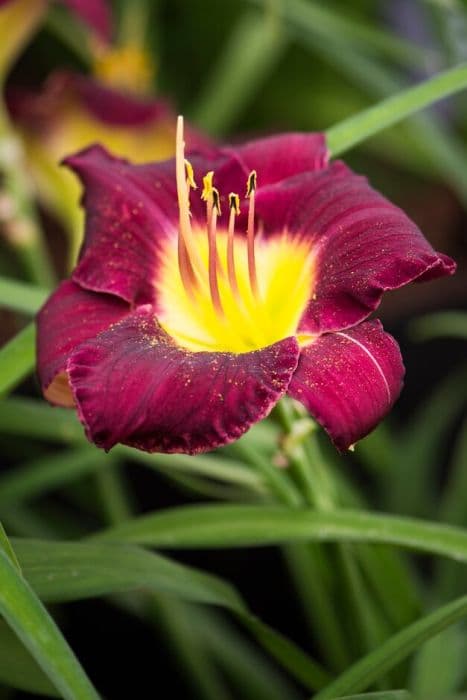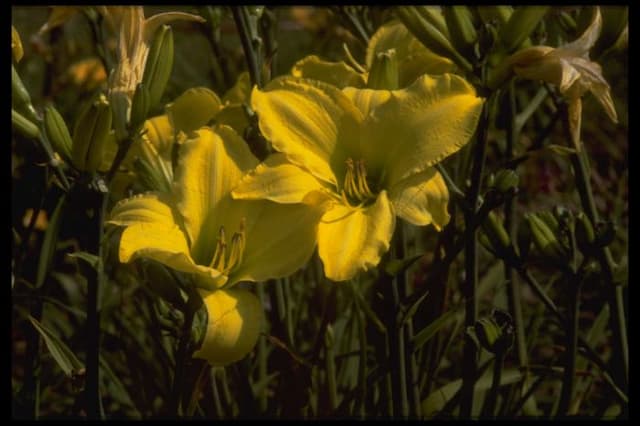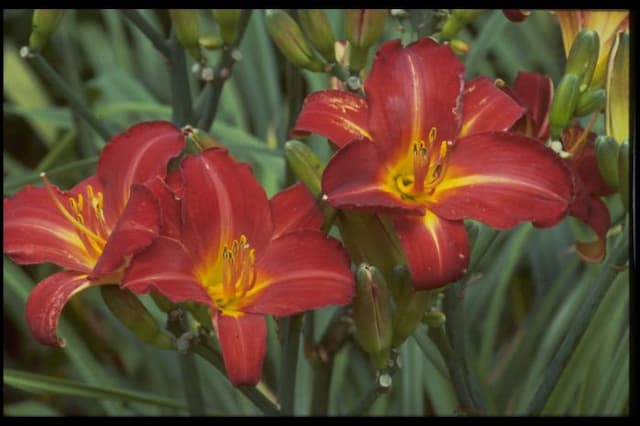Daylily 'Ver00322' Hemerocallis Everydaylily Red Ribs = 'Ver00322' (PBR) (Everydaylily Series)

ABOUT
[EveryDaylily Red Ribs] is a compact perennial to around 50cm tall with arching, narrow leaves and two-toned, deep red flowers with yellow throats, edgings and mid-ribs; flowers are produced successionally over a long season from late spring to late summer
About this plant
 Names
NamesFamily
Asphodelaceae
Synonyms
Everydaylily Red Ribs, Red Ribbed Daylily, Red Ribbed Hemerocallis
Common names
Hemerocallis Everydaylily Red Ribs = 'Ver00322' (PBR) (Everydaylily Series).
 Characteristics
CharacteristicsLife cycle
Perennials
Foliage type
Deciduous
Color of leaves
Green
Flower color
Red
Height
2 feet (60 cm)
Spread
2 feet (60 cm)
Plant type
Herb
Hardiness zones
3
Native area
Asia
Benefits
 General Benefits
General Benefits- Low Maintenance: Requires minimal care once established, making it ideal for busy gardeners or those who prefer a more laid-back approach to gardening.
- Drought Tolerant: Adapted to survive with limited water, reducing the need for frequent watering once established.
- Attractive Blooms: Produces vibrant red flowers with distinctive ribbing, adding eye-catching color to garden beds and landscapes.
- Long Blooming Period: Offers a prolonged display of flowers throughout the season, keeping gardens lively and colorful over an extended period.
- Hardy Grower: Demonstrates good resistance to common garden pests and diseases, ensuring a healthier and more robust plant.
- Suitable for Containers: Can be grown in pots or containers, giving flexibility for those with limited garden space or who wish to adorn patios and balconies with living color.
- Perennial Lifespan: As a perennial, it will return year after year, offering long-term value and reducing the need for annual replanting.
- Adaptable: Thrives in a variety of soil types, from clay to sandy soils, making it a versatile choice for different garden settings.
- Pollinator Friendly: Attracts beneficial insects like bees and butterflies, promoting biodiversity and supporting a healthy ecosystem.
- Propagates Easily: Can be propagated through division, allowing gardeners to easily expand their plantings or share with fellow gardening enthusiasts.
- Aesthetically Versatile: Its striking flowers and foliage complement a wide range of garden designs, from cottage gardens to modern landscapes.
- Edging Plant: Suited for use as a border or edging plant, it helps define garden spaces with its consistent growth habit.
- Easy to Combine: Pairs well with other perennials and annuals, offering ample opportunities for creative garden compositions.
 Medical Properties
Medical PropertiesThis plant is not used for medical purposes.
 Air-purifying Qualities
Air-purifying QualitiesThis plant is not specifically known for air purifying qualities.
 Other Uses
Other Uses- The Daylily can be used for natural dyes, particularly from the flower petals, providing a range of colors from yellows to oranges depending on the mordant used.
- Daylily leaves can be woven into baskets or used in other forms of fiber arts as they are long, strong, and flexible when fresh.
- The tubers of the Daylily can be ground into a starchy paste and used as a thickening agent in cooking, similar to cornstarch.
- Daylily flowers can be added to ice cubes to create decorative and edible elements for cold beverages during summer events.
- The fibrous roots of the Daylily can be used to stabilize soil on slopes and prevent erosion due to their dense spreading habit.
- When placed in a pond or water garden, Daylily plants can provide hiding spaces for small aquatic wildlife and contribute to a balanced ecosystem.
- Used in companion planting, Daylilies can be planted around vegetables to add color to the garden plot and potentially distract pests.
- Daylilly's sturdy stalks can be used in lieu of skewers for grilling small pieces of food, imparting a subtle herbal flavor to the dish.
- The dried seed pods of Daylilies can be used in floral arrangements or as part of homemade potpourri for their unique shapes and textures.
- Daylilies can be planted in containers on patios or balconies where other plants might struggle, as they are hardy and adaptable to various conditions.
Interesting Facts
 Feng Shui
Feng ShuiThe Daylily is not used in Feng Shui practice.
 Zodiac Sign Compitability
Zodiac Sign CompitabilityThe Daylily is not used in astrology practice.
 Plant Symbolism
Plant Symbolism- Longevity: The common name for Hemerocallis is "Daylily," which is often associated with longevity due to the plant's ability to thrive and bloom year after year.
- Motherhood: Daylilies can symbolize motherhood because of their nurturing way of producing numerous offspring or bulblets, signifying fertility and abundance.
- Forgetfulness: Each bloom of a Daylily typically lasts just one day before fading, which can be a reminder of the fleeting nature of life and memory.
- Survival: Daylilies are known for their hardiness and ability to survive in a range of conditions, symbolizing resilience and adaptability.
 Water
WaterDaylilies like the Everydaylily Red should be watered thoroughly about once a week, allowing the soil to dry between waterings. During the growing season, especially if the weather is particularly hot or dry, you may need to water twice a week. Apply water directly to the soil to avoid wetting the foliage, using approximately 1 gallon of water per plant for each watering session. Ensure proper drainage to avoid waterlogging, which can lead to root rot. During the winter dormant period, reduce watering frequency as the plant's water requirements decrease.
 Light
LightDaylilies, including the Everydaylily Red, thrive in full sun, meaning they prefer at least six to eight hours of direct sunlight each day. They can tolerate partial shade, particularly in the hottest parts of the day, but too much shade can reduce blooming. Choose a spot in your garden that gets ample sunlight for the healthiest growth and best flower production.
 Temperature
TemperatureDaylilies like the Everydaylily Red are quite hardy and can tolerate a range of temperatures. They grow best in temperatures between 60°F and 90°F but can survive in temperatures as low as 20°F and as high as 90°F. To encourage optimal growth, protect them from extreme heat or freezing conditions by providing mulch or shade during the hottest part of the day and insulation during winter if necessary.
 Pruning
PruningPruning Daylilies like the Everydaylily Red helps remove dead foliage and spent flower stalks, which encourages reblooming and maintains a tidy appearance. Deadhead the flowers regularly to stimulate additional blooms. After blooming has finished for the season, cut back the foliage if it looks unkempt or damaged. The best time for pruning is in early spring and late fall.
 Cleaning
CleaningAs needed
 Soil
SoilThe daylily (Hemerocallis) thrives in a well-draining soil mixture composed of garden soil, compost, and perlite or sand to increase aeration and drainage. The ideal pH range for daylilies is between 6.0 and 6.5, which is slightly acidic. Mulching can help to maintain moisture and provide nutrients as it decomposes.
 Repotting
RepottingDaylilies, including the Everydaylily Red Ribs, typically don't need frequent repotting. They can be repotted or divided every three to four years or when the clump becomes crowded and the flowering diminishes.
 Humidity & Misting
Humidity & MistingDaylilies, such as the Everydaylily Red Ribs, are adaptable to a wide range of humidity conditions and do not require high humidity to thrive; average outdoor ambient humidity is generally sufficient for their growth.
 Suitable locations
Suitable locationsIndoor
Place in bright, indirect light and maintain moderate watering.
Outdoor
Plant in well-draining soil with full sun to partial shade.
Hardiness zone
4-9 USDA
 Life cycle
Life cycleThe daylily 'Everydaylily Red Ribs' begins its life cycle as a dormant rhizome or rootstock, which emerges in early spring. As temperatures increase, it produces strap-like foliage that forms a clump, and soon develops flower scapes that rise above the leaves. Throughout late spring and summer, it enters its flowering stage, with each individual blossom lasting only a day, yet the plant continually produces new buds for an extended bloom period. Post flowering, the plant sets seed pods if pollination has occurred; however, in cultivated varieties like 'Ver00322', propagation is often done through division rather than seeds. As the growing season ends, the daylily's foliage will die back with the onset of autumn and enter a period of dormancy during the winter. With the return of favorable conditions in the subsequent spring, the plant will re-emerge from dormancy and repeat the cycle.
 Propogation
PropogationPropogation time
Spring to Summer
The Hemerocallis, commonly known as daylily, is typically propagated through division, which is the most popular method for the Everydaylily Red Ribs. This method involves separating the plant into smaller sections, each with a portion of the root system. The best time to do this is in early spring or after the plant has finished flowering, usually in late summer to early fall. To propagate by division, carefully dig up the plant while trying to keep the root ball intact. Use a sharp knife or spade to cut the clump into smaller sections, ensuring that each section has at least one growing fan of leaves and a part of the root system. These divisions can then be immediately replanted in the garden at the same depth they were growing before, spacing them about 18 to 24 inches (approximately 45 to 60 centimeters) apart to allow room for growth. Water the newly planted divisions thoroughly to help establish them.









